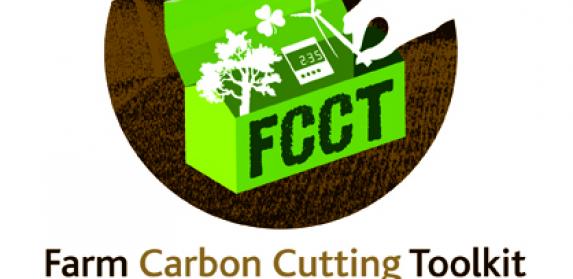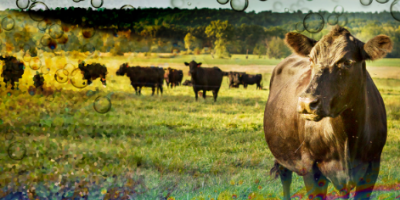This is a reposting of a commentary on the report Grazed and Confused? written by the organisation Farm Carbon Cutting Toolkit. We are reposting the piece with their permission; you can read it on their website here.

 Last Monday brought a new report released which has received quite a lot of media attention focussing on the greenhouse gas impact of grazing livestock, and the potential for grasslands to provide benefits in terms of sequestering carbon.
Last Monday brought a new report released which has received quite a lot of media attention focussing on the greenhouse gas impact of grazing livestock, and the potential for grasslands to provide benefits in terms of sequestering carbon.
It’s a reassuringly weighty document, (127 pages to be precise) which draws conclusions from a wide breadth of academic papers which have looked as aspects of this contested question: “do grazing livestock and grasslands bring a positive aspect to the climate debate by storing carbon in the soil.” This is an often overlooked part of the equation when considering the environmental impact of consuming ruminant products.
Its taken a few days to read and inwardly digest the report, read some of the comments and responses to it that have come from other organisations, and to consider a response from FCCT to it.
The full link to the report is here.
The report is broken down into sections, looking at:
- Defining grass – fed systems, grazing lands and the numerous variations that exist under these broad terms
- Understanding the contribution of ruminants to wider agricultural GHG emissions
- Soil carbon sequestration and the contribution of grazing livestock to the amount of carbon that is held in the soil
- A focus on the other greenhouse gas emissions arising from ruminant production, methane and nitrous oxide
- The role of grazing systems on land use and land use change
It then comes to some conclusions, based on the evidence that has been presented.
The issues around ruminant production
 It is not a new issue that grazing livestock produce methane, which is more potent in terms of its warming potential than carbon, and that every day that these animals are alive they are producing more methane. Logic therefore suggests, that the quicker that we can get beef animals to their ideal carcass weight, (and therefore on the consumers’ plate) the better. As such, grass doesn’t stack up as a good feeding solution, as due to the fibrous nature of grass and forage, the animal has to expend energy digesting the forage that could be used to grow and lay down more meat or produce more milk. If we follow this argument, if the animal is fed more digestible and energy dense foods (for example grain or soy based diets) then the animal is finished quicker and is thus more efficient.
It is not a new issue that grazing livestock produce methane, which is more potent in terms of its warming potential than carbon, and that every day that these animals are alive they are producing more methane. Logic therefore suggests, that the quicker that we can get beef animals to their ideal carcass weight, (and therefore on the consumers’ plate) the better. As such, grass doesn’t stack up as a good feeding solution, as due to the fibrous nature of grass and forage, the animal has to expend energy digesting the forage that could be used to grow and lay down more meat or produce more milk. If we follow this argument, if the animal is fed more digestible and energy dense foods (for example grain or soy based diets) then the animal is finished quicker and is thus more efficient.
The often proposed counter argument is that this is a potential oversimplification. Often these calculations don’t take into account the inputs and processes that go into growing this feed for stock, and the potential land degradation that exists to grow these products. Furthermore the potential for humans to eat these crops (such as cereals) directly, would negate the need for them to go through an animal first.
We, as humans can’t eat grass, and as such, to get any nutritional value from that, we have to develop systems that utilise this grass in an efficient way and turn it into a digestible form of protein that we can eat – generally through ruminants such as cows or sheep.
To try and counter this (by some people’s calculations) inefficient way of producing beef, interest has grown over the last few years in the benefits that grasslands provide in terms of soil health and sustainability, and how grazing management can be altered to produce animals efficiently whilst balancing the benefits that come from growing a perennial crop. This includes the area of soil carbon sequestration, and the ability of grasslands to hold carbon in the soil to a greater extent than systems that includes regular cultivations and growing of annual crops.
This report is quick to point out that it has a narrow focus looking just at greenhouse gas emissions, and is not considering some of the other points that are often cited within these debates, including biodiversity, social and cultural issues, food security, food waste and hydrology.
The link with sustainable consumption
 This report also looks at sustainable meat consumption, and current consumer patterns, concluding:
This report also looks at sustainable meat consumption, and current consumer patterns, concluding:
“if not addressed, the increasing global demand for meat will result in serious and potentially irreversible consequences for the environment, because it will require large areas of virgin land to be converted to grain production.”
Consumption patterns is slightly outside the remit of FCCT, but it is a stark reminder that although as farmers we play a vital part in this issue, in order to truly achieve change it requires a much wider and potentially more difficult conversation.
What does the report conclude?
Having read the full report and experienced a slight sense of overwhelming doom as I read on, the conclusions brought me slight relief, and gave me some hope.
Firstly the report concludes that:
“Well managed grazing in some contexts can cause carbon to be sequestered in the soil”
How long carbon can be sequestered for, at what rate and what happens to it in the long term are all up for discussion, and need more research, but we have farmers that we are working with who are achieving gains now. The report also includes the caveat that this potential is highly context specific, as well as concluding that:
“the relationship between soil carbon sequestration and grazing intensity is complex”
 However this complexity brings with it an opportunity. An opportunity for farmers and scientists to work together to understand this in more detail. Working with complex biological systems that rely on the weather is something that farmers are dealing with every day. Every farm is unique, and a big challenge with addressing emissions from agriculture, is that it isn’t one size fits all. This is where we need farmers to help. A glaringly obvious fact to us at FCCT is the distinct lack of farm level data, to start to understand where it is possible and where the results are less favourable. This is something that needs to be addressed now.
However this complexity brings with it an opportunity. An opportunity for farmers and scientists to work together to understand this in more detail. Working with complex biological systems that rely on the weather is something that farmers are dealing with every day. Every farm is unique, and a big challenge with addressing emissions from agriculture, is that it isn’t one size fits all. This is where we need farmers to help. A glaringly obvious fact to us at FCCT is the distinct lack of farm level data, to start to understand where it is possible and where the results are less favourable. This is something that needs to be addressed now.
On my Nuffield travels over the last 18 months, I have been lucky enough to meet some of the pioneering farmers who are leading on this issue across the world, including farmers who are signed up to 10 year carbon agreements in Australia, and are working with the Healthy Soils Initiative in America. These trials, as well as the (very) small ones that we are working on here in the UK, will start to add real life data to the models that populate a lot of the results of the peer reviewed work that is cited.
Building carbon in the soil, as the report acknowledges, doesn’t have to be exclusive to grassland systems, and is possible within arable and mixed farming systems as well, as long as soil health is central to business management. This soil health revolution is happening now, on farms around the world, and provides a unique opportunity for farmers and environmentalists to work together. We must not lose this opportunity to engage farmers.
The other irrefutable point that this report makes is that whatever the scope for sequestration, it is essential to emphasize the importance of ensuring that all management keeps existing carbon in the ground and vegetation. Avoiding carbon release is even more important that trying to sequester it. FCCT completely agrees with this.
Metrics / claims and measuring change
 Throughout the report there are examples cited of beneficial carbon claims of management practices, the different ways of accounting for gases being emitted, the issue of how carbon stocks under the ground are measured, and the difficult nature of unravelling all of the ways of accounting for changes in emissions based on management practices. This is something that we need to address now.
Throughout the report there are examples cited of beneficial carbon claims of management practices, the different ways of accounting for gases being emitted, the issue of how carbon stocks under the ground are measured, and the difficult nature of unravelling all of the ways of accounting for changes in emissions based on management practices. This is something that we need to address now.
Current reporting methodologies for national GHG contributions are inherently meaningless to farmers, as they don’t show the information that is needed to inform management change. However attempts to develop farmer-level accounting that allows scrutiny of these issues at farm level, are often not considered robust enough and are disputed.
There is a need to work together to develop metrics that are based on real farm data, have worth at farm level but are also robust enough to explore these issues in detail, and are using the same terminology to report on.
Efficient production
 FCCT work with all farmers to help improve efficiency and reduce their environmental impact, whatever their system. There is considerable scope for farmers to improve efficiency through better use of resources, planning nutrient applications, reducing waste streams, improved skills and knowledge, as well as the opportunities for building soil health. By labelling one production system as ‘bad’ and another as ‘good’ we overlook these opportunities.
FCCT work with all farmers to help improve efficiency and reduce their environmental impact, whatever their system. There is considerable scope for farmers to improve efficiency through better use of resources, planning nutrient applications, reducing waste streams, improved skills and knowledge, as well as the opportunities for building soil health. By labelling one production system as ‘bad’ and another as ‘good’ we overlook these opportunities.
The report also lays down a challenge for now and the coming years, which is “to figure out the environmentally least bad way of using land and other resources to nourish ourselves and meet our other development goals.”
This is a challenge which will need the inclusion of research, policy makers, innovators, consumers, environmentalists and farmers. FCCT would be happy to share results of its on-farm work with the authors of the report and others to help address this challenge.













Post a new comment »